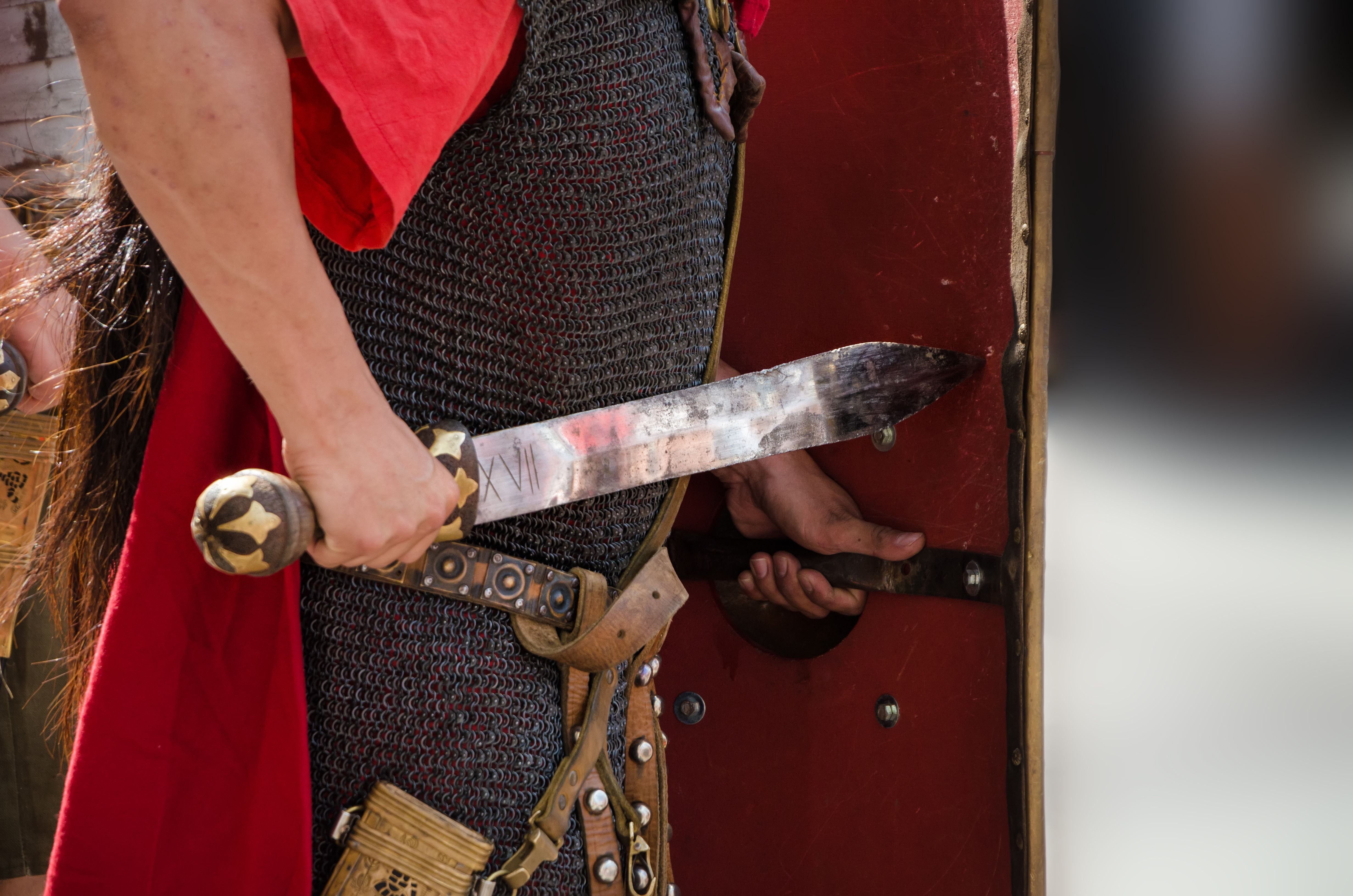
The gladius is a short sword, about 2 feet long, used by soldiers in the Roman army. In the hands of trained legionnaires, the gladius was a potent offensive weapon.
Roman soldiers would advance side-by-side with their shield, called a scutum, held in their left hand and a gladius in their right hand. In this position, the sharp tip of the gladius was best used as a thrusting weapon to stab the enemy, aiming for the torso. In ancient times, an abdomen wound was usually fatal.
With a two foot length and sharp double edges, the gladius could also be used as for slashing or cutting. From comments I’ve read, the main use was for thrusting.
While the main use was thrusting, preferable for the abdomen, legionnaires were trained to take slashes of opportunity, say an exposed knee within reach below the opponents shield. In the other direction, if a shield was lowered, a slash at arm or neck could also end the fight in a moment.
(Note: This post has been updated and expanded several times. For ease of reading, the revisions will not be identified as such.)
Wikipedia describes the various sizes of gladii (plural of gladius – yeah, I had to look it up):
- weight – ranged from 1.5 up to 2.2 pounds
- blade length – from 18 to 27 inches
- total length – between 24 and 33 inches
- blade width – from 2 to 2.8 inches.
Romans were skilled at working with steel, thus a gladius was made of strong steel, although impurities would undercut the blade’s strength.
Wikipedia reports four variations of gladii are known. They are:
- Gladius Hispaniesnisis
- Mainz gladius
- Fulham gladius
- Pompeii gladius
Wikipedia says the Mainz and Pompeii were the main categories.
Following are the closest illustrations I could find to match the descriptions:
Gladius Hispaniesnisis
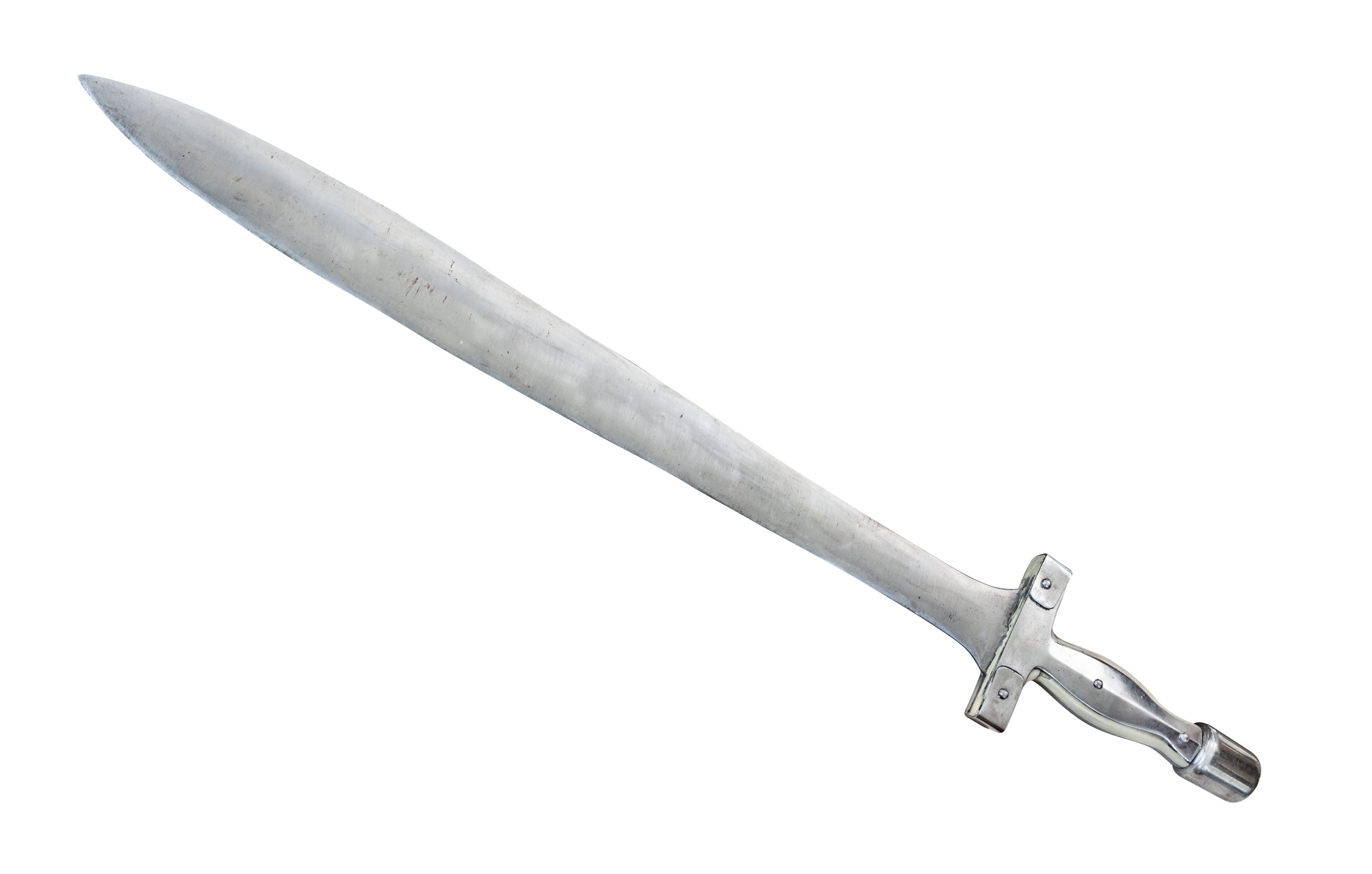
Roman Soldier Operations Manual: Daily Life * Fighting Tactics * Weapons * Equipment * Kit by Simon Forty says these were from 24″ to 32″ long, around 2″ wide, weighing around 35 ounces. Design was picked up from either Celto-Iberian mercenaries or the Celts. Produced from around 216 BC until 20 BC.
Mainz gladius

Operations manual mentioned above suggests these were from 19″ to 27″ long, about 3″ wide, weighing in at around 28 ounces. Production started somewhere in the hundred years after 100 BC.
Fulham gladius

Operations manual mentioned above suggests these were same size as Gladius Mainz at 19″ to 27″ long, bu narrower at 2.5″ wide, weighing in a slightly lighter 25 ounces. Produced probably the same time as the Mainz. Book says both the Mainz and Fulham might tend to snapping due to the narrow waist of the blade, which probably made it weaker than the Pompeii gladius.
Pompeii gladius
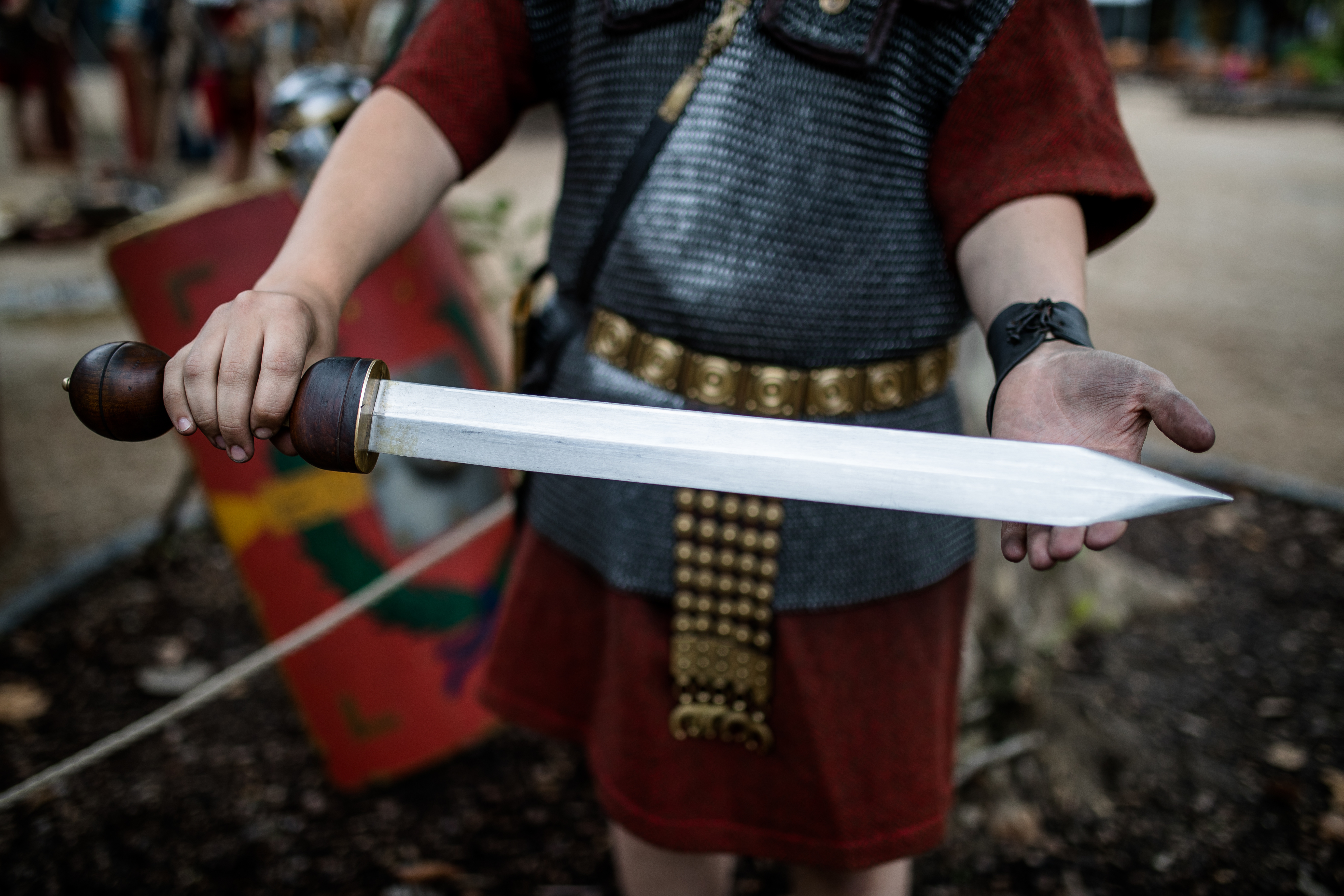
Roman Soldier Operations Manual says the pompeii model ranged from 18? to 24?, width about 2?, weight about 25 ounces. with its straight edges would have had more cutting and slashing power. Production started sometime in 1st century AD. The shorter point would have made it stronger, thus less likely to break. Being a simpler design, it was probably cheaper to produce.
Legionary: The Roman Soldier’s (Unofficial) Manual by Philip Matyszak takes a tour of the Roman army from the fictional perspective of a soldier planning to enlist as a Legionnaire. After explaining terms of enlistment and training, the book provides a description of life in the army, both in camp and on campaign. One chapter describes the legacy of many Legions. Various items in a soldier’s kit are described.
The book describes the most important factor for a sword is balance. A soldier can instinctively know the “sense of point” of a balanced sword and thus can tell where the point is and move it accordingly without even seeing the sword. That would be handy in a battle where fractions of a second determine who goes home and who gets buried that day. Also, when well-balanced, a gladius is easier to handle.
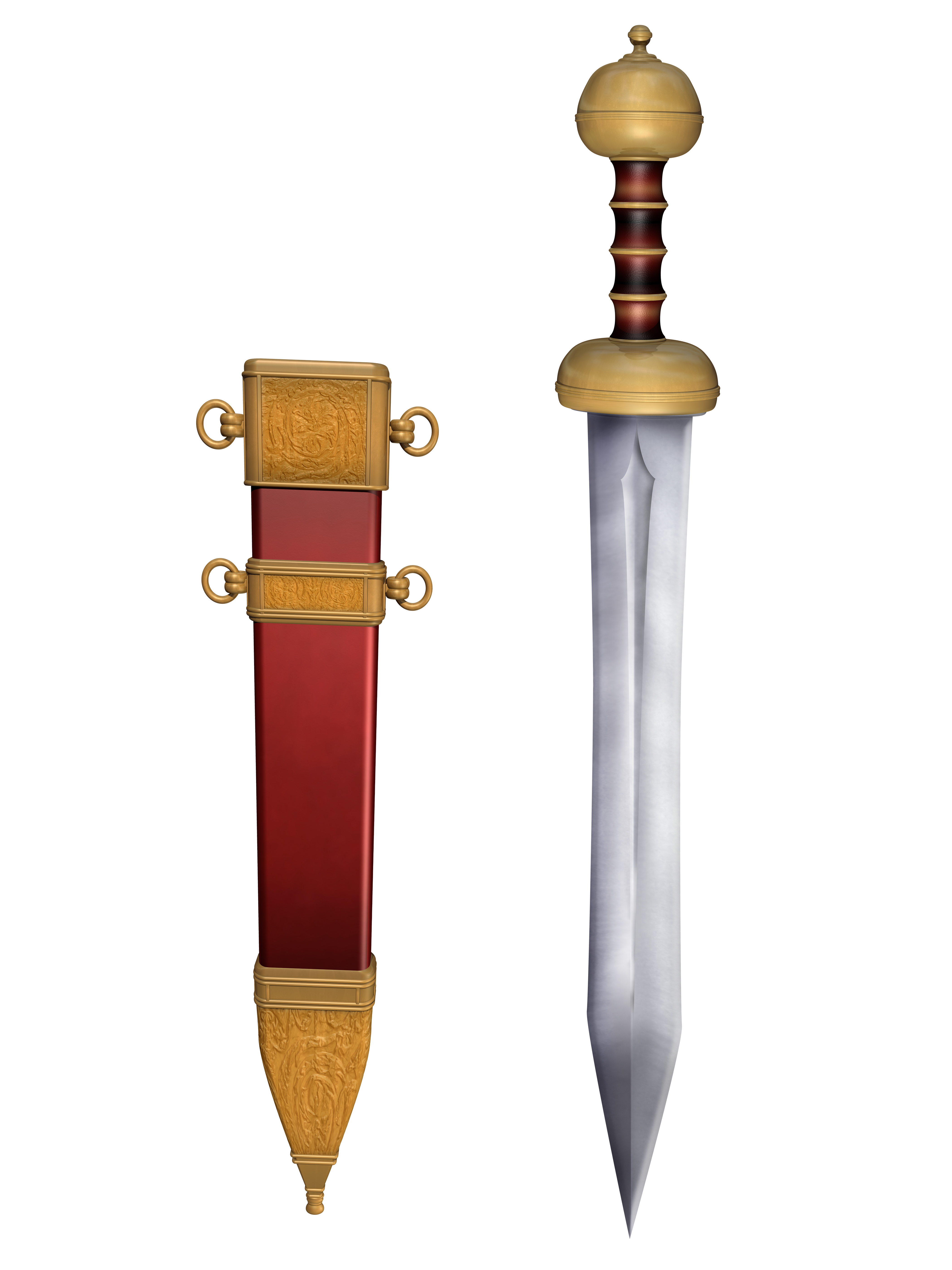
Roman swords usually did not contain blood runnels. Suffice it to say that after stabbing your opponent, you would need to sharply twist the sword to withdraw it, thus making it available for the next enemy who just stepped into line.
UPDATE 4/27/22: See discussion in comments which explain the ‘blood runnel’ is not actually a thing. The fuller in a sword (the groove) exists to reduce weight of the blade without loss of strength. A lighter blade means faster movement. Would also result in less physical drain from swinging a several pound weapon.
Legionary explains the best grip is bone, which is better than rawhide, which is better than wood.
Before buying a sword, the book recommends making sure the part of the blade going into the handle, or tang, is well attached to the pommel, which is the round part at the back of the sword. The pommel is large to help balance the sword and round for ease of grip when extracting the sword.
The book also says the scabbard should be built specifically for the sword to get the best fit. Too loose a fit may make noise when you want to be silent and too tight means it might be difficult to draw the sword.
Most comments I’ve read say the sword was carried on the right side for ease of draw when holding a scutum (shield) in front of the body. Would be difficult to clear the arm and shield in a cross draw. Centurions (commanders of a century, or company of men) did not carry a scutum so they wore the gladius on the left side.
A long belt draped over the left shoulder held the scabbard. Only a few of the comments I’ve read suggest it would have been worn on a belt.
Spatha
Near the end of the 2nd century, the Roman army started transitioning to a long sword, called spatha.

The blades were between 2 and 2.5 feet long (24″ to 30″) per Wikipedia. Roman Soldier Operations Manual: Daily Life * Fighting Tactics * Weapons * Equipment * Kit by Simon Forty says the spatha was between 2.5 and 3.25 feet long (30″ to 39″).
Whether 24, 30, or 39 inches long, the spatha had a longer reach than the 18 inch to 24 inch Pompeii sword. That would give a Legionnaire the ability to reach out and touch someone an extra 10 or 15 inches away.
The blade was straight with a longer hilt (handle).
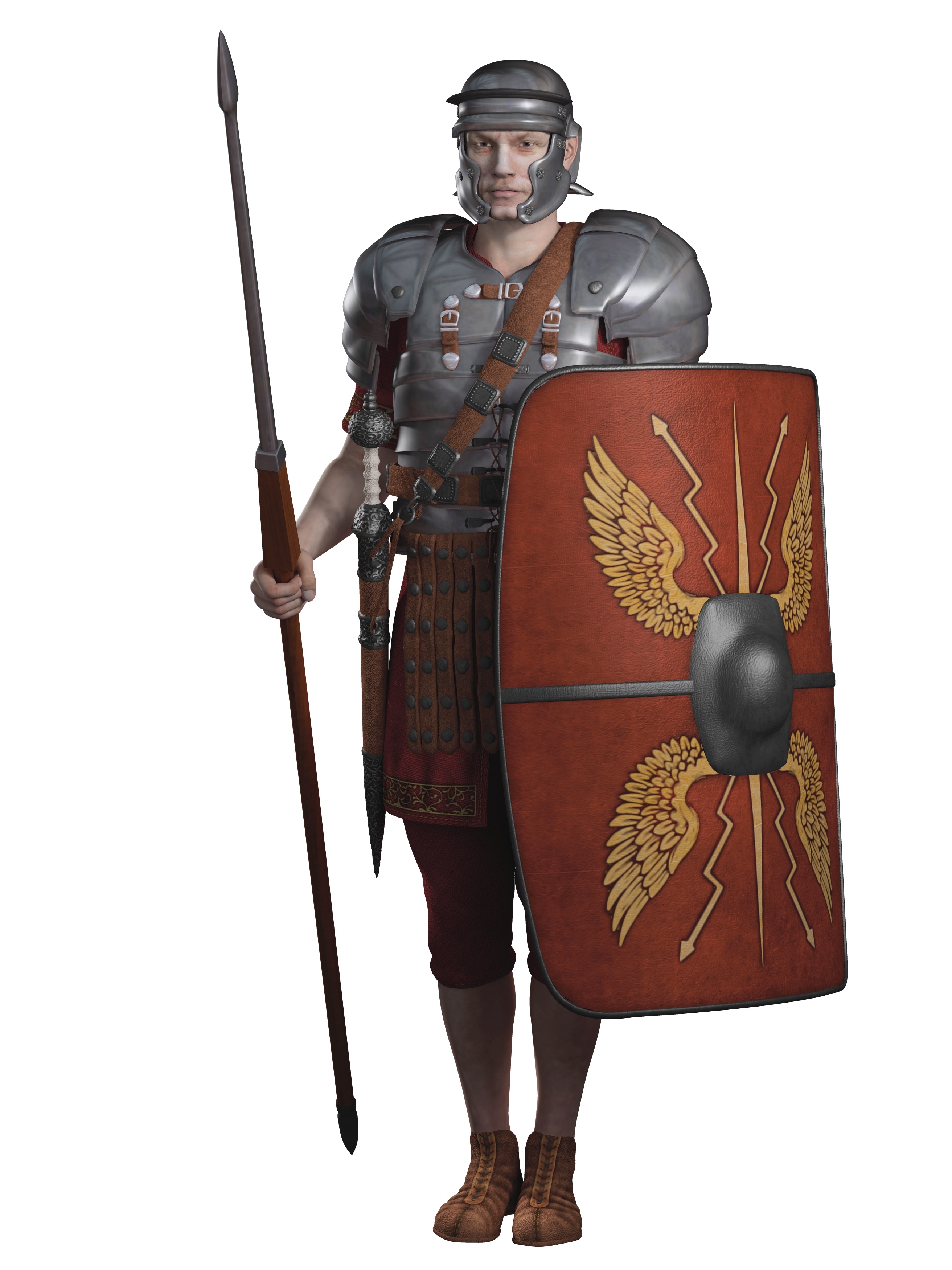
The Operations Manual book says a transition to a long sword was needed because heavy infantry wasn’t always the determinative factor on the battlefield. As a result, a looser battle strategy was needed. Thus the longer sword.
Both the Wikipedia article and Roman Soldier Operations Manual say the spatha evolved into the long sword of the medieval knights fame.
But first, Wikipedia says the spatha carried over into the Byzantine Empire and was used by the Varigians. Those were the Scandinavian Vikings who served as mercenaries in the Empire.
One of the more famous Varingians was Harald Hardrada. After leaving service of the Emperor at the lofty rank of captain in 1042 AD, he took his wisdom & skill, the massive wealth he had accumulated, and his followers. He returned to Norway to claim the kingship, which he did in around 1046. He invaded England (again) but was defeated & killed at the battle of Stamford Bridge in 1066.
So, the Vikings, and all the other Europeans, made extensive use of the derivatives of the spatha.
Thus we can connect a line from the Roman legion using the gladius, then the spatha, to the Byzantine Empire, to the Vikings, to the end of the Viking Age. Now you can jump to the 60 posts on my blog discussing the Vikings.
Recap of all designs:
| length | length | width | weight (oz) | |
| Gladius Hispaniesnisis | 24″ to | 32″ | 2.0″ | 35 |
| Gladiu Mainz | 19″ to | 27″ | 3.0″ | 28 |
| Gladius Fulham | 19″ to | 27″ | 2.5″ | 25 |
| Gladius Pompeii | 18″ to | 24″ | 2.0″ | 25 |
| Spatha (Wikipedia) | 24″ to | 30″ | ||
| Spatha (Operations Manual) | 30″ to | 39″ |
Pugio
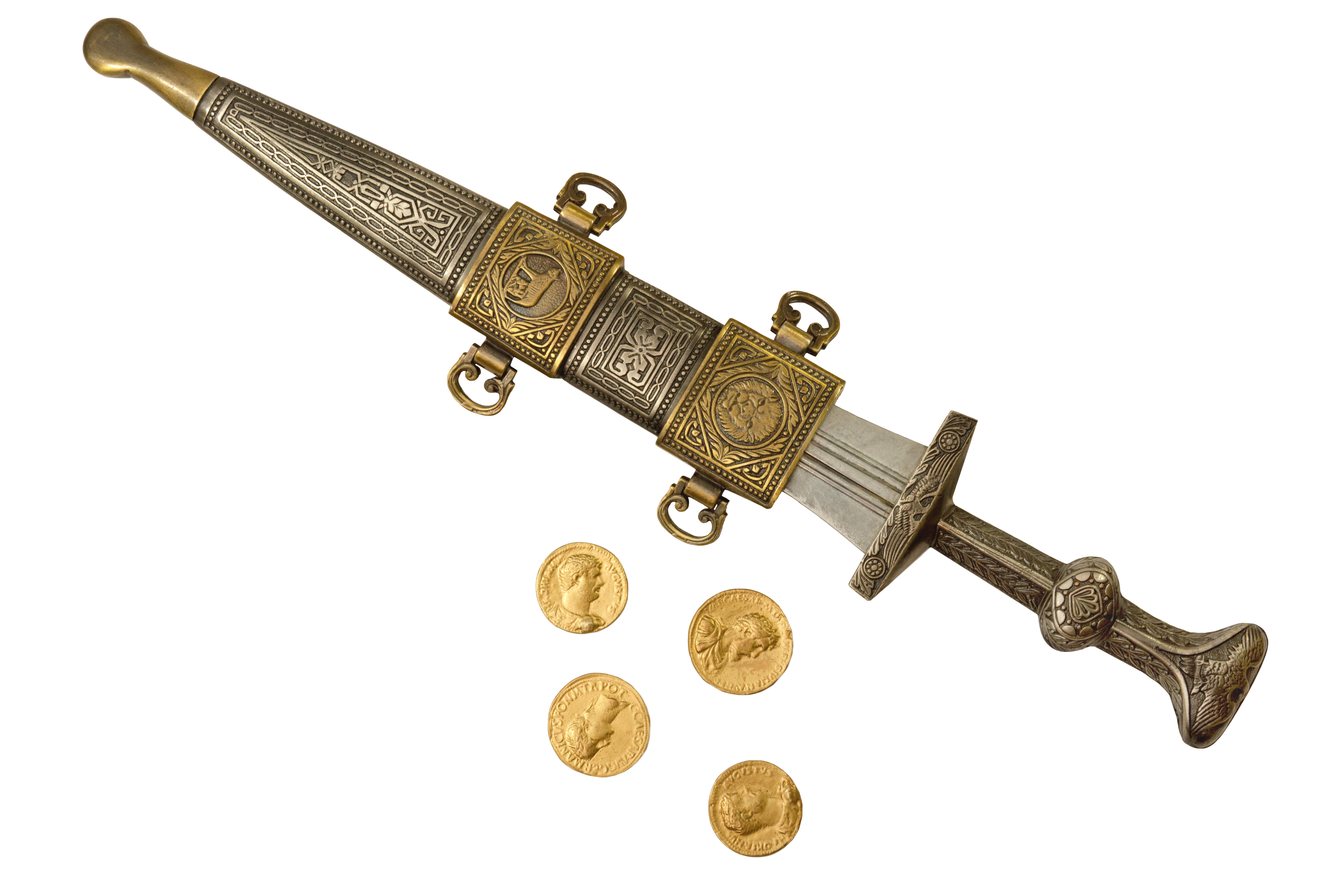
On the opposite side of the body from the gladius, a soldier would carry a dagger, called a puglio pugio. (Yeah, yeah, I had it misspelled. Three times. Update to the update: The book Legionary: The Roman Soldier’s (Unofficial) Manual uses puglio.) That would be used in many day-to-day activities whenever a cutting blade was needed.
One writer said there are lots of utility knives found in excavations of Roman camps. So, the pugio may have been expensive enough that other knives were used for day-to-day chores with the pugio used as last ditch defense weapon, decoration, or if daily knife wasn’t otherwise available.
Take your pick of stories.
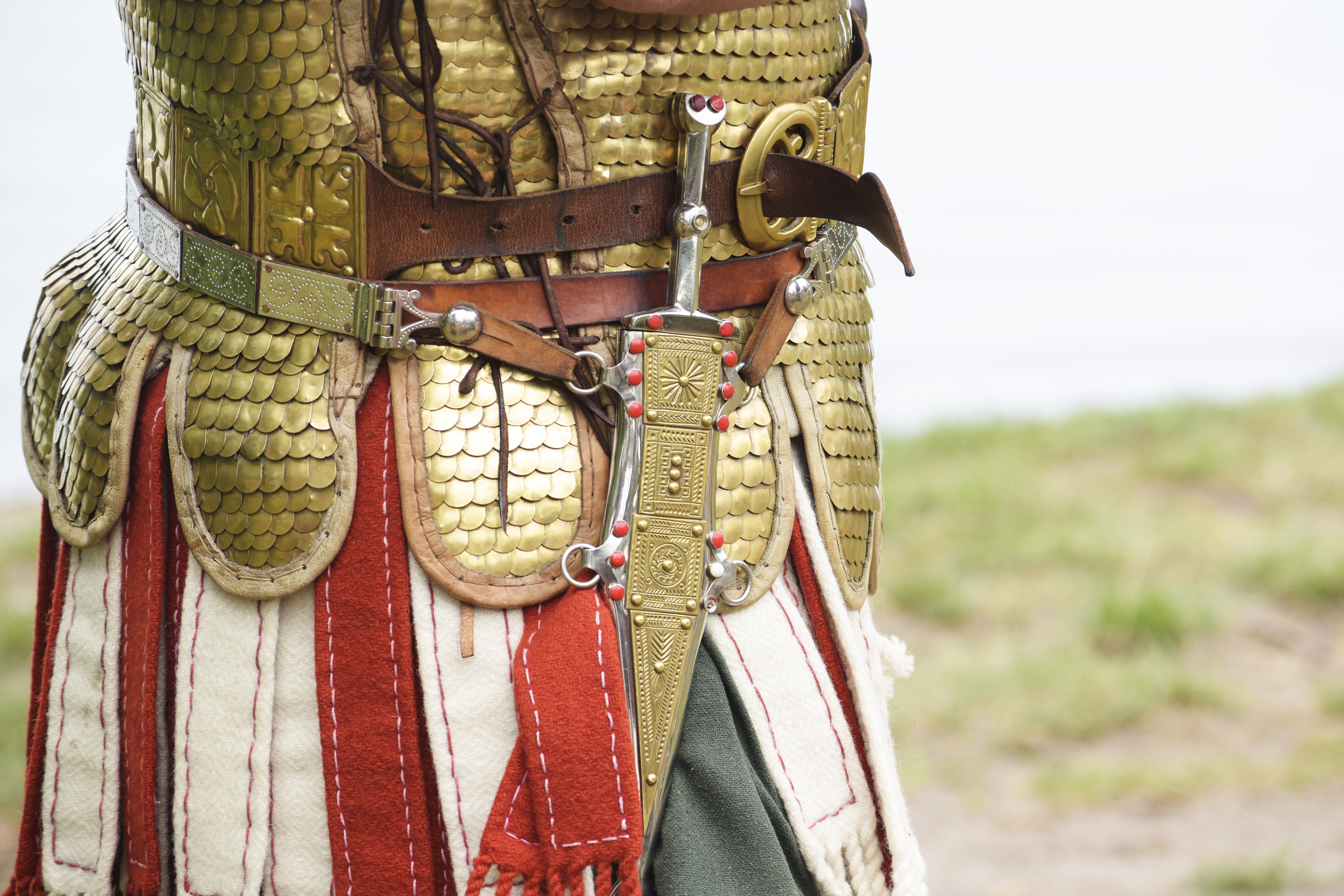
The Roman Army, The Greatest War Machine in the Ancient World edited by Chris McNab provides a timeline of when different styles of gladii were introduced (yeah, yeah, I had to look up the plural form of gladius again to make sure it was correct):
- Gladius Hispaniesnisis used until around 20 B.C. That is longer one, wider toward the tip and narrower toward the tang (hand grip).
- Mainz / Fulham gladius rapidly adopted somewhere around 20 B.C. These ranged from 16″ to 22″ in length. Discovered examples weigh in at between 2.6# and 3.5#.
- Pompeii gladius introduced sometime in mid 1st-century. This design had straight edges and a short triangular tip. Book says these ranged from 18″ to 22″ and were around 2.2 pounds.
If you want to overlay this with biblical times, the Mainz and Fulham designs would have been the common weapon during the time of the Gospels, when Jesus was residing on earth. The Pompeii design would have been coming into common use during the early events describe in Acts of the Apostles. By the time of most of Paul’s writings, such as Ephesians, the Pompeii design would have been in widespread use. I can only guess whether it would be most common by then. Swords last a long time and would probably be used until they broke.
Other posts on weaponry of a Roman Legionnaire:
- Introduction
- Scutum – shield
- Gladius – sword
- Caligae – Sandals
- Lorica Segmentata – segmented breastplate armor
- Galea – Helmet
- Pilum – javelin
Upcoming posts:
- Cloak
2 thoughts on “Gladius, sword used by Roman Legionnaires. Other edged weapons.”
“Roman swords usually did not contain blood runnels. Suffice it to say that after stabbing your opponent, you would need to sharply twist the sword to withdraw it, thus making it available for the next enemy who just stepped into line.”
This is entirely false. “Blood runnels” are not a thing and that has nothing to do with what the grooves are for. Bodies aren’t vacuums that latch onto your blade, the idea that they are is absolutely absurd.
Hello Tyler:
I stand corrected.
A few minutes research on the ol’ internet shows the fuller (far better term that runnel) is used to lighten the sword at minimal loss of strength of the blade. A lighter sword means more agility when a little bitty advantage can mean the difference between life and death. Merely two articles making the point:
* Why is there a groove in swords? It’s NOT a blood groove – the video explains better https://www.thevintagenews.com/2016/08/11/groove-swords-not-blood-grove/?chrome=1
* blood groove https://www.sword-buyers-guide.com/blood-groove.html
First article asserts a fuller could reduce weight by 20% to 35% and would not sacrifice strength or blade integrity.
A commenter on the second article listed asserts in event of a thrust through the lung, the runnel would increase amount of air introduced to plural cavity thus accelerating a collapse of the lung. Not too sure a small groove would add much to the damage if a several inch wide blade had just penetrated the lung, so consider that as you wish.
Thank you Tyler, for taking the time to comment and helping me grow.
Jim